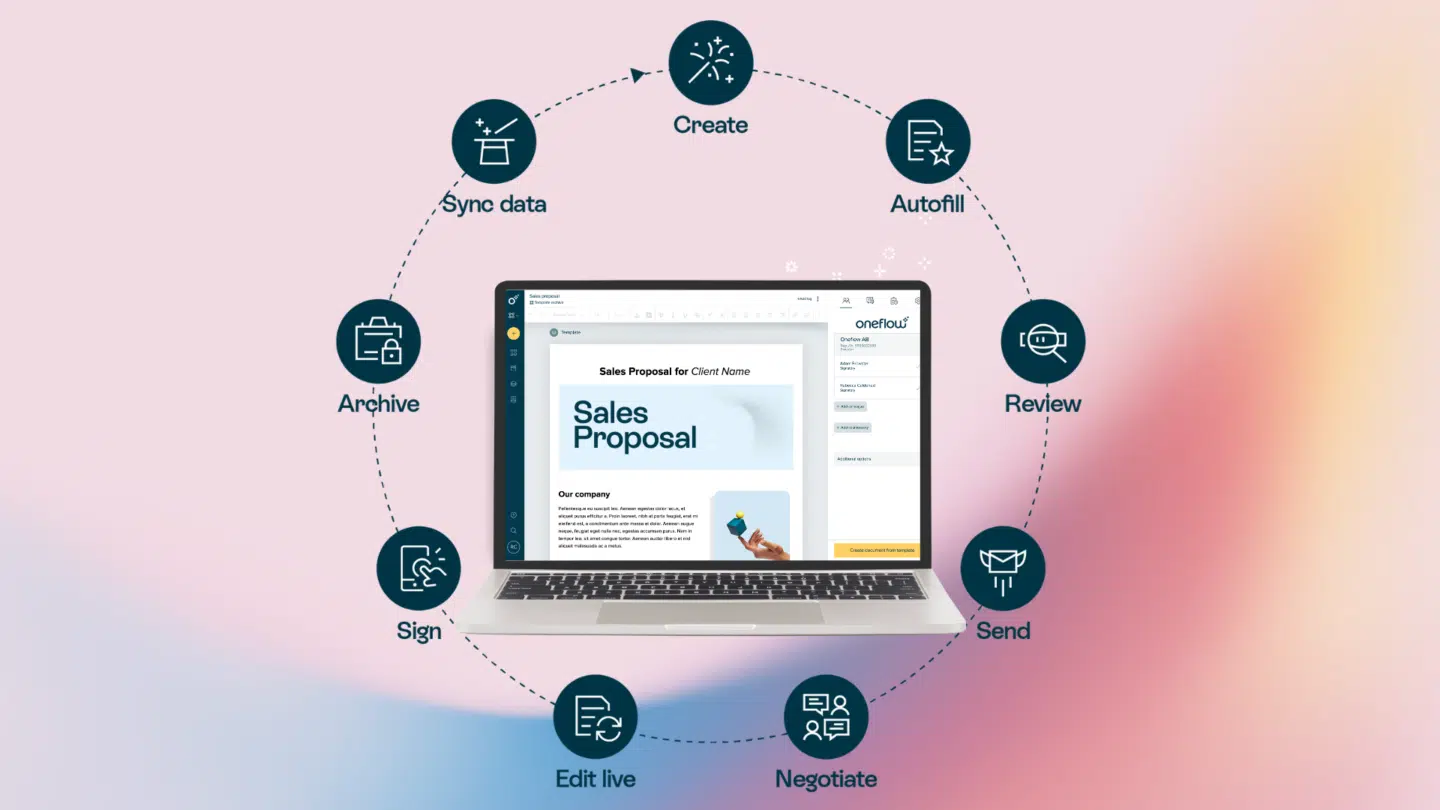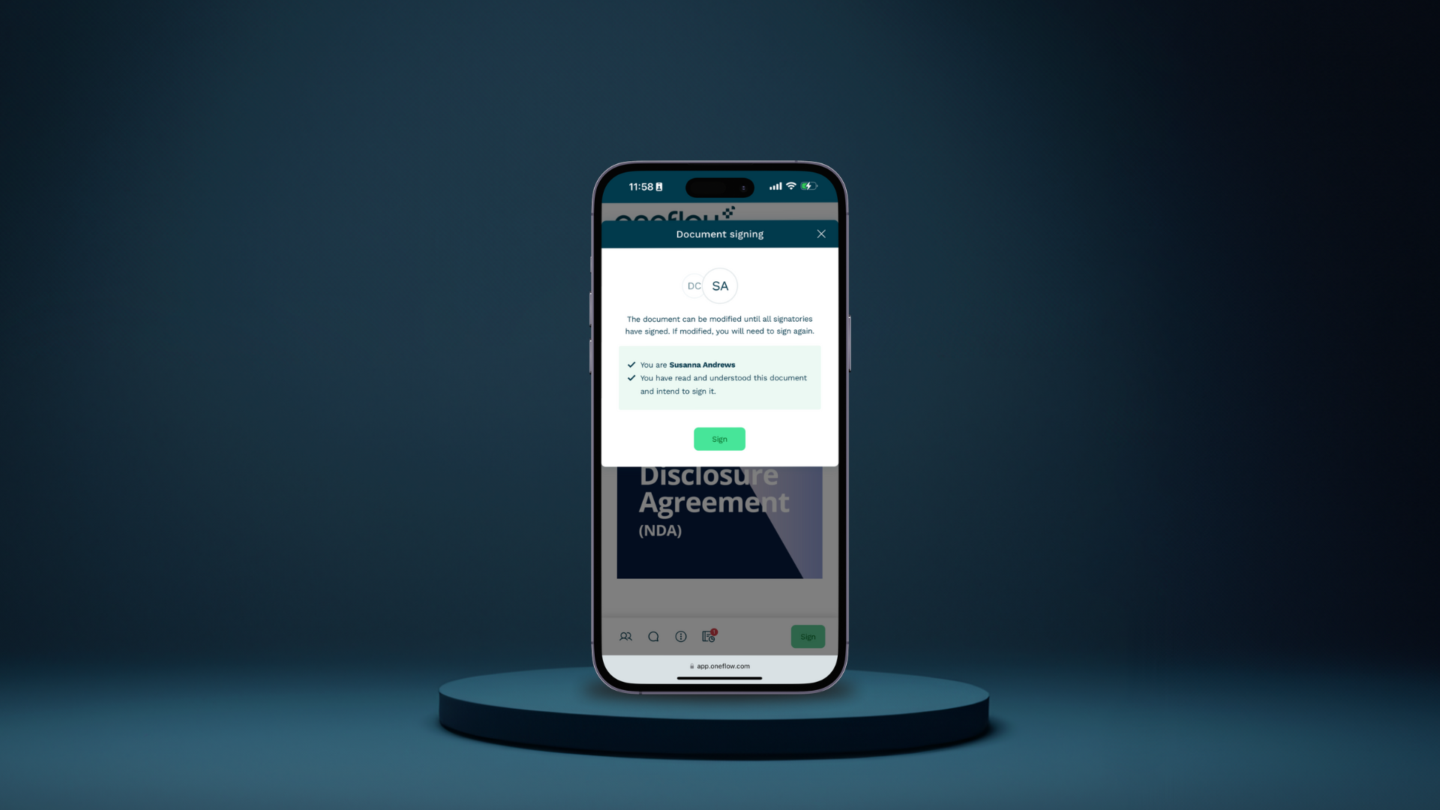This website uses cookies so that we can provide you with the best user experience possible. Cookie information is stored in your browser and performs functions such as recognizing you when you return to our website and helping our team to understand which sections of the website you find most interesting and useful.
Home > Electronic signatures: The benefits and how it works
Electronic signature: The benefits and how it works
Did you know that the term electronic signature can refer to a wide range of signing methods? It includes everything from simple e-signs to advanced, legally binding digital signatures.
In this article, we’ll explain what each type of electronic signature means and help you decide which to use when. We’ll also explain all the benefits e-signing brings, starting with increased efficiency and improved security.
We’ll also show you how to create your own electronic signatures so you can handle documents more efficiently. Keep reading to learn more.
What is an electronic signature?
An electronic signature is a cost-effective and secure way to get electronic documents signed quickly.
Now, if you’re asking yourself – is an electronic signature legally binding? The good news is that it is, in fact, legally binding in the vast majority of countries around the world and can carry the same weight and legal effect as an inked or handwritten signature.
See also: Handwritten signature vs electronic signatures
Electronic signature vs digital signature – what’s the difference?
You might have heard the terms “electronic signature” and “digital signature” used as if they mean the same thing, but they’re not completely alike.
An electronic signature can be as simple as a scanned image of your signature or even the signature you use at the bottom of your emails.
Digital signatures are a type of electronic signature that uses special technology to keep documents safe and ensure they haven’t been changed. Think of it as a secure code that gets added to a document, kind of like a high-tech version of your handwritten signature.
Creating and managing electronic signatures with Oneflow
If you were looking for electronic signatures online, you probably came across various solutions. Now, you may be wondering – what’s the difference between them?
The main distinctions among e-signature tools are in terms of their ease of use, level of security, pricing and other features they provide.
Oneflow is a super user-friendly and versatile solution that allows you to sign contracts online and create different types of electronic signatures: from standard and handwritten signatures to eIDs.
But it’s much more than that. Oneflow is a comprehensive contract automation tool that lets you take control over the whole contract lifecycle management. It comes with plenty of templates for all types of documents, so you can create, sign, track and manage your documents in one place.
It stands out from other tools because you can create multiple types of electronic signatures with only one click. Choose among:
- Standard e-signature (SES): This is the most popular option for those situations when you need to sign something quickly. We provide you with an encrypted link allowing you to sign with only one click.
- Handwritten signature: If you prefer so-called wet ink signatures, you should check out the Oneflow handwritten signature feature. It allows you to either draw your signature by hand or choose one of the many available fonts. Our handwritten signature is not only beautiful but most importantly, it carries the same legal validity as a standard electronic signature.
- SMS verification: If you want to verify a signer’s identity, we can send them a 6-digit code via SMS.
- Electronic ID: If you need an additional layer of safety and identification, you can opt for eID. Oneflow has eIDs for many countries, including the UK and most EU countries.

Here’s what else is possible with Oneflow:
- Creating contracts using templates
- Live collaborating before and after sending
- Storing contracts in an organized archive
- Setting internal reminders for resigning periods
- Exporting processable data about the contents of your contracts
A step-by-step guide to creating electronic signatures
Now that you know what our tool offers, it’s time to see it in action. Here’s how to create an electronic signature with Oneflow.
- Create a free account and fill in your data.
- Click on the Marketplace section from the menu on the left side.

- You’ll see a variety of add-ons. Click on the Handwritten Signature add-on to activate it (don’t worry, you don’t have to pay anything extra).

- When signing a document, you’ll have two options to choose from. First, you can draw your own signature using your mouse or touchpad.

- If you want it to look more polished, simply type your name and choose a font you like from Oneflow’s various styles.

- You can preview multiple versions until you find the one you like the most. Then, click on the Sign button and you’re all set.
We also have detailed guides on how to convert your existing signature into an e-signature:
- How to convert a signature to an e-signature
- How to convert image to signature
- How to convert JPEG and PNG images to and e-signature
The different types of e-signatures
Oneflow offers both simple (SES) and advanced electronic signatures (AdES). The first option comes in many forms, which include the following.
Standard e-signature
This is the most commonly used form of electronic signature, where you sign documents with a click of a button through a private, encrypted link. Click here to see how to sign a PDF online for free.

SMS or text message
If you choose to sign documents with an SMS or text message, your signer will receive an SMS with a 6-digit code, and they will use it to confirm their identity when signing the contract.

Handwritten signature
A handwritten signature is also known as a wet ink signature and can be convenient when you want your signer to sign “on the same device.” This method enables you to draw or write your signature and has the same legal effect as a standard electronic signature.
Click here to learn how to create a handwritten signature online or how to create a cursive e-signature.

Electronic identification
This method allows you and your counterparty to sign your contracts using electronic ID. To provide secure and reliable eIDs and advanced signatures in a wide range of countries, it partners with Signicat, the leading eID broker in EU/EEA and a Qualified Trust Service Provider.

Is an electronic signature secure and safe?
When it comes to the U.S., in short, yes, e-signatures are safe and secure, thanks to laws that protect their use in the U.S. There are two primary laws: the Uniform Electronic Transactions Act (UETA) and the Electronic Signatures in Global and National Commerce Act (E-Sign Act).
UETA has been adopted by most states to ensure that electronic signatures are legally valid. The E-Sign Act, established in 2000, reinforces this by stating that e-signatures hold the same weight as traditional handwritten ones for contracts, even across state lines.
For an e-signature to be valid, the signer must intend to sign, and all parties should have access to the signed information. While they’re generally secure, it’s important to ensure proper storage and access to maintain their validity.
There are three types of electronic signatures: simple, advanced and qualified, with qualified signatures meeting the most requirements and simple signatures the least.
In Europe, on the other hand, eIDAS makes electronic signatures legally valid, so courts can’t dismiss them just for being electronic.
If you’re interested in exploring this topic further, we have whole articles about this:
A basic guide on electronic signatures and what makes them legal
What are the benefits of using electronic signatures?
Here are the top three reasons to implement electronic signatures.
Speed up time-to-sign
When negotiating contracts, the printing, signing and posting processes can take days, if not weeks. Once the recipient receives the documents, they will repeat the same actions before you can receive the document.
This back-and-forth is frustrating and time-consuming. With a digital contract, you can close a deal within minutes using signatures in the electronic form. Digital contract software like Oneflow also allows editing the document after it’s been sent so that you don’t need to rewrite and reupload a contract every time you make changes.
Review and sign anywhere
The modern world loves the idea of on-the-go. Make it easy for your counterparty to review and sign your contract anywhere. Have them sign it from any device – a mobile phone or laptop – wherever they go as long as there’s Internet. E-signatures make it easy for anyone to sign documents from anywhere.
Click here to learn how to make a signature on a computer or on a Mac.
Stay secure and compliant
Change the entire contract signing process from a tedious manual task to a streamlined electronic process, reducing the risks of costly errors and legal consequences. With digital contract automation software like Oneflow, you can have customizable user permissions, BankID signing and internal reminders to stay compliant and secure.
To discover more, check out these 16 reasons to start electronic signature and e-contracts.
Which departments benefit from e-signatures?
Electronic signatures can be used across all industries. Here are some examples of how they can be used to simplify the process for your clients and boost employee productivity in different sectors of your company.
Sales
E-signatures streamline the sales process by eliminating the need for physical paperwork and manual signing. Sales teams can send contracts, agreements and proposals to clients electronically, facilitating faster turnaround times. E-signatures enhance the customer experience by reducing delays and simplifying the signing process, ultimately accelerating deal closure and revenue generation.
HR
HR departments deal with numerous documents that require signatures, such as employment contracts, offer letters, onboarding forms and employee policies. E-signatures simplify the HR workflow by enabling digital document signing and eliminating printing, scanning and physical storage. This improves efficiency, saves time, reduces errors and enhances the employee onboarding experience.
If you want to learn about the specific features HR teams benefit most from, check out our solutions for HR for more information.
IT and ops
IT and operations teams often handle contracts, vendor agreements, service-level agreements and other operational documents. E-signatures enable these departments to streamline processes by digitizing document signing. IT teams can also benefit from e-signatures when obtaining approval for system changes, software deployment or access permissions. E-signatures reduce administrative overhead, improve compliance and facilitate faster decision-making.
For more information about the specific features IT&Ops teams benefit most from, check out our solutions for IT and ops.
Legal
Legal departments frequently handle contracts, nondisclosure agreements, legal notices and other legal documents that all require signatures. E-signatures help with faster turnaround times, increased security, improved audit trails and reduced costs associated with printing, shipping and storage. These solutions often include advanced authentication and encryption measures, ensuring the integrity and authenticity of the signed document.
Finance
Finance departments handle various financial agreements, such as invoices, purchase orders, vendor contracts and expense reports. Implementing e-signatures simplifies processes by enabling digital signing, reducing paperwork and improving efficiency. E-signatures also provide faster access to financial documents, enhance compliance and offer an audit trail for tracking signatures and approvals.
To read more about the specific features finance teams benefit most from, click here to discover why Oneflow is a contract platform for all departments.
Those were just some of the departments that could benefit from using e-signatures, but the list is much longer.
See also:
- E-signatures in real estate
- Electronic signatures in procurement
- How e-signatures benefit accounting
What features to look for in electronic signature solutions
You should pick an e-signature tool that fits your needs and complies with electronic signature laws in your industry and in your country. Here are some universal features to look for:
- Browser-based vs PDF-based contract creation: Pick a software that allows you to create contracts in a dynamic browser-based format, instead of only uploading static PDFs. This capability will benefit you in the short run by making live editing and collaborating easier. However, it will also help you in the long run by allowing you to download the metadata from all your contracts to track changes and optimize new documents based on historical data.
- Multi-team capacity: Having different teams using different electronic signature providers can result in an auditing and legal nightmare. Make sure your software can meet all your teams’ needs and host all of your different teams’ templates with user permissions. That way, employees will only see the contracts relevant to them to avoid confusion and privacy issues.
- Live collaboration and editing: With remote work gaining popularity, it’s more important than ever to be able to collaborate with your colleagues and counterparties directly in the contract software. With a service like Oneflow, you can edit documents live with your colleagues and leave internal or external comments.
- Contract archive: Storing your contracts in a different software from the one you use for sending adds additional risk. Employees can forget to save the latest version of a contract, store it in the wrong place or forget about it when it needs to be renewed. Pick a tool with automatic, searchable storage and internal reminders for all contract lifecycle events.
Conclusion
Managing signatures can often feel overwhelming, especially with the volume of contracts businesses handle. This is where e-signatures step in, streamlining the signing process and enhancing security.
But Oneflow is much more than just an e-signature tool. Think of it as multiple tools in one. With Oneflow, you can create, edit and sign documents without switching tools.
Oneflow stands out as a modern, secure and user-friendly solution for contract management that comes with plenty of templates and different formats for e-signatures, including electronic and handwritten signatures.
Try Oneflow today for free and transform your contract processes for the better!
FAQs
How do I create an electronic signature?
There are several ways you can create an e-signature, such as signing your name with a pen and scanning it, using free online tools, Microsoft Office etc. However, if you want to streamline your signing process and have a fully secure electronic signature, we suggest using dedicated e-signature tools such as Oneflow.
What is the difference between a digital signature and an electronic signature?
The main difference between a digital signature and an electronic signature is that a digital signature uses encryption for added security and integrity. In contrast, an electronic signature can be something simple, like a scanned image of your signature. Digital signatures are generally more secure and reliable than basic electronic signatures.
Is a PDF signature an electronic signature?
A PDF signature can be either an electronic or a digital signature. With a tool like Oneflow, you can easily add electronic signatures to your PDF documents.
How legal is an electronic signature?
According to federal law, an electronically signed document is legally valid and can be used in court. However, if it’s not a Qualified Electronic Signature (QES), you must prove the signer’s identity. A QES provides an audit trail and requires in-person verification, making it a more reliable option for confirming the signature’s legality.
Book a demo of Oneflow
Book a demo of Oneflow
"*" indicates required fields






